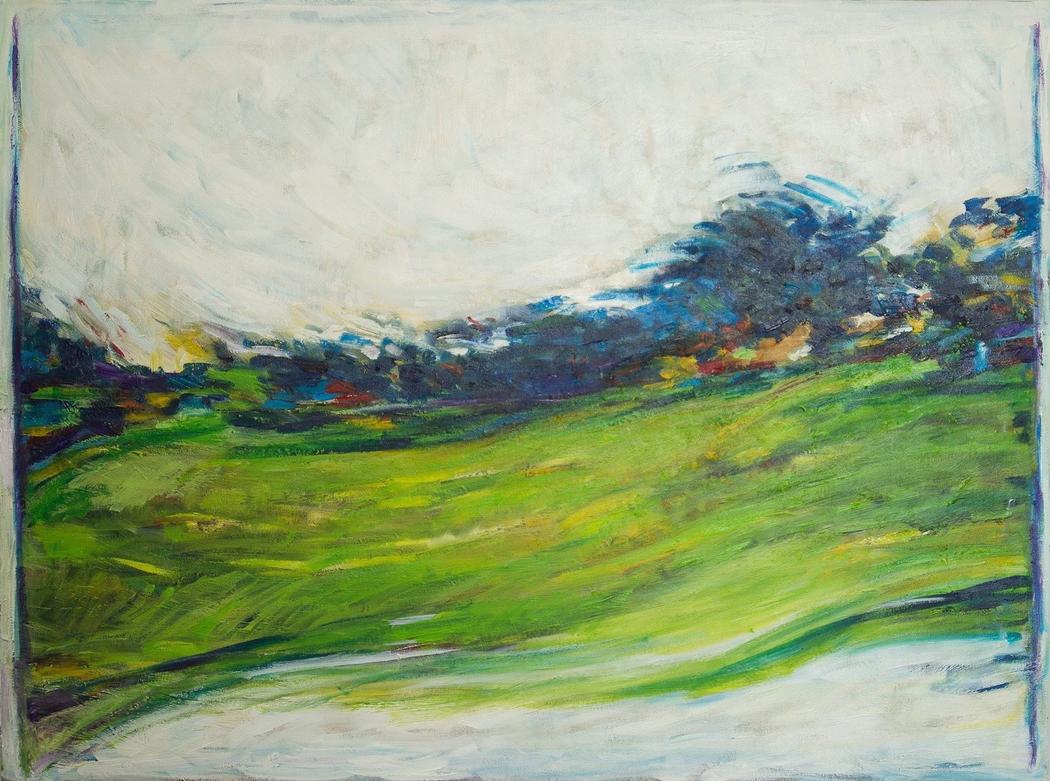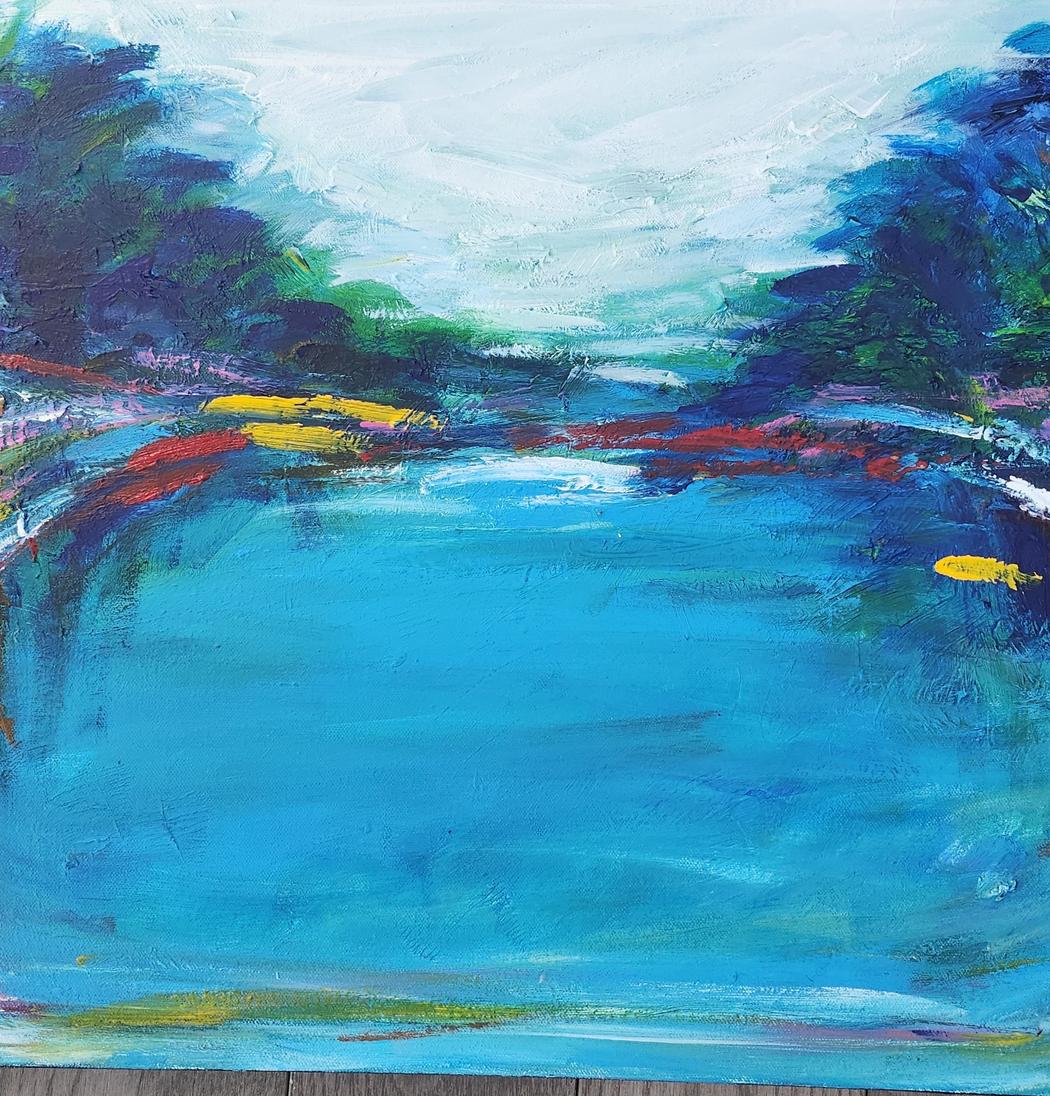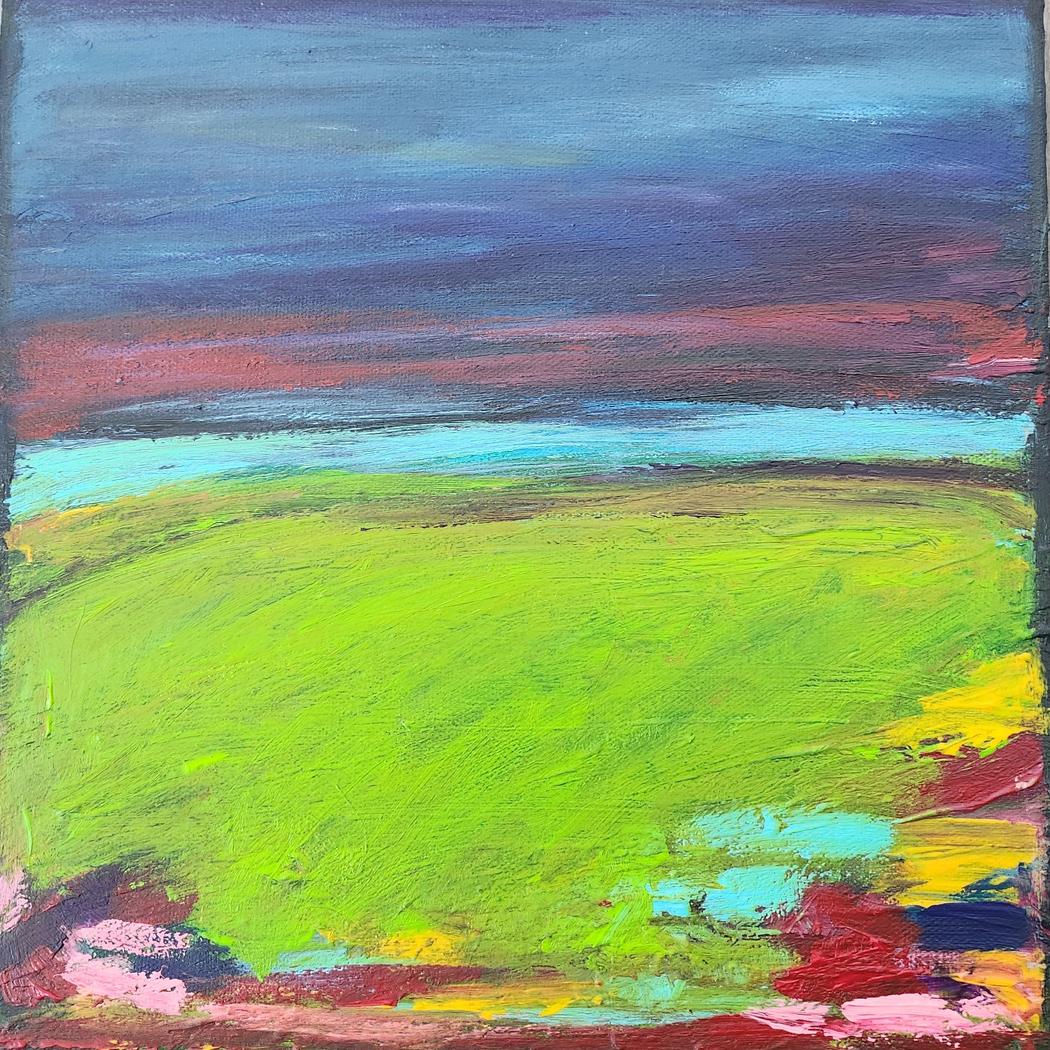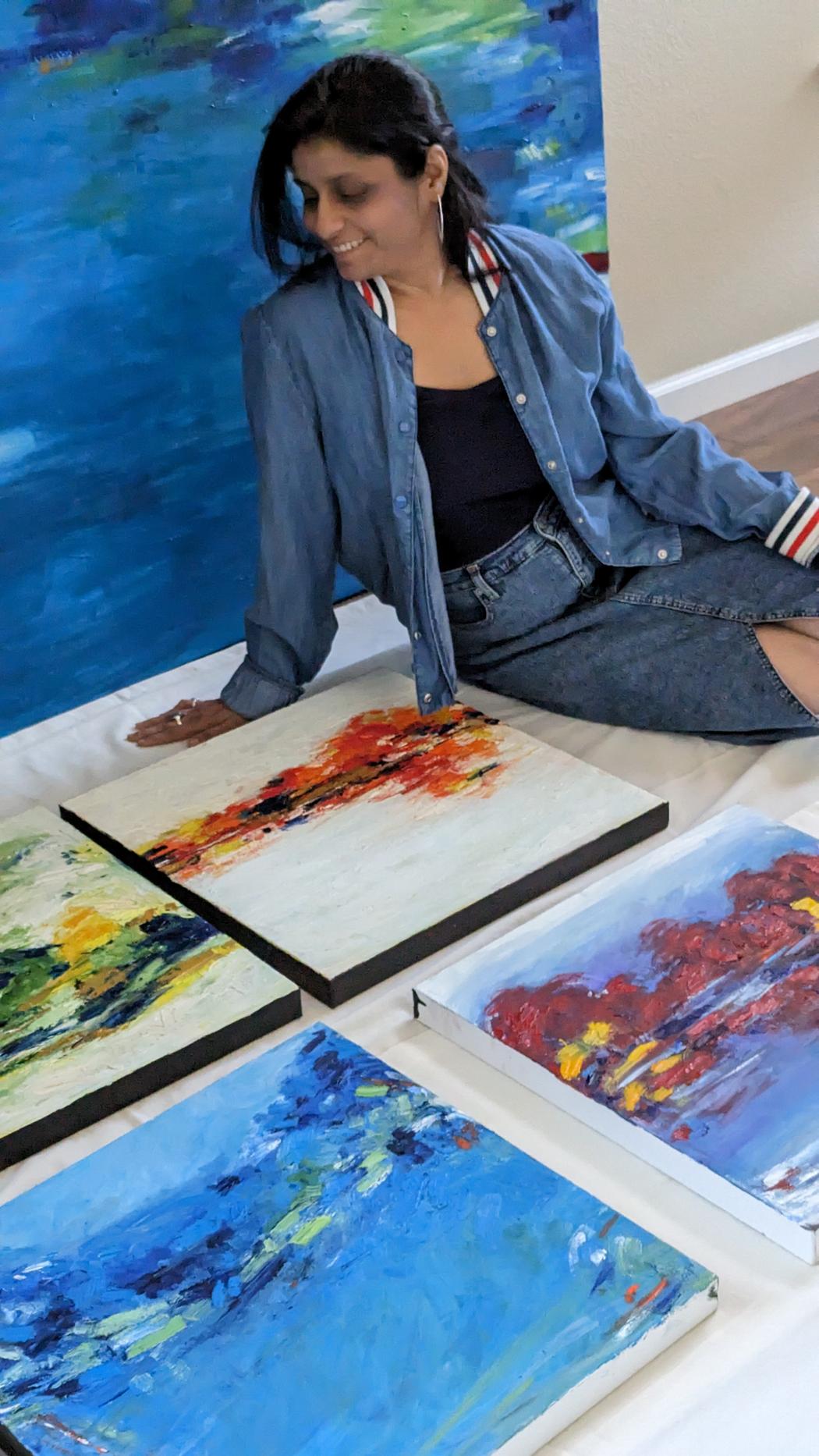Kajal Zaveri
Describe your art in three words: Emotive. Expansive. Reflective.
Your discipline: I work primarily in acrylic and oil, creating expressive landscapes within the realm of abstract realism. My process is intuitive and layered, balancing freedom with emotion. I also teach and lead inclusive art workshops focused on creative connection.
Website | Instagram
Your art blends abstraction and realism beautifully. How do you decide how much of each to include in a painting?
Nature’s wisdom with its quiet cycles of growth, renewal, and stillness inspires much of my work. I often begin with something rooted in the natural world, the soft curve of a tree line, the vastness of sky, or the rhythm of moving water. But rather than depicting it literally, I allow the painting to evolve through intuition and emotion. What begins as a recognizable form soon transforms into something more open, more mysterious. I intentionally blur the details to create space for the viewer’s imagination and emotion to enter.
In my practice of Abstract Realism, I’m drawn to the space between clarity and ambiguity. It’s not about rendering a perfect landscape but it’s about translating emotion, and not just imagery. The familiar elements serve as gentle entry points and beyond that I don’t want to define the entire journey. I want to create a sense of spaciousness and openness, where memory, emotion, and reflection can unfold naturally. Abstraction gives me that freedom. It invites the viewer to feel rather than analyze. Realism provides the anchor, the suggestion of place or mood. By navigating this fine line between the real and the abstract, I aim to create not just a scene but an experience—something that encourages presence, evokes emotion, and allows for a deeply personal connection. Ultimately, it’s not about what’s seen on the canvas, but what’s felt beyond it.
Nature plays a central role in your work. Do you paint from specific places or from memory and feeling?
Nature is always the starting point of my art and my main muse, but I don’t aim for literal representation. I paint from memory, from feeling, and from emotional impressions of the natural world. I absorb landscapes and internalize the misty coastlines, the open skies, rolling hills, wildflowers, urban parks, and many such similar encounters and then reinterpret them and share them through an internal lens. These elements stay with me and reappear in my paintings, layered with emotion. My nature-inspired works are rooted in feeling rather than form. Through layers of color, shifting forms, and intuitive brushwork, I don’t try to capture a landscape exactly but rather the way it feels to stand in it. A breeze through trees. The hush of dawn. The weightlessness of sky. The expanse of the ocean. Even when my brush references a place, it’s filtered through memory and instinct. I invite viewers to engage with the work on an emotional level, finding their own connections and interpretations within the interplay of color, form, and movement and offer them a sense of connection, and the quiet joy of being present, a place where they can pause, feel, and reconnect with the rhythm of something greater.
 Kajal Zaveri | Somewhere Feeling Fresh | 2025
Kajal Zaveri | Somewhere Feeling Fresh | 2025
You describe your works as “soulscapes.” Can you elaborate on what that term means to you artistically and emotionally?
I use the word soulscapes to describe a lot of my nature inspired landscapes. For me this signifies a visual expression of what lies beneath the surface: memory, stillness, longing, strength. The term came to me because I was looking for a way to describe work that felt deeply personal, yet didn’t belong to any specific place. These aren’t literal scenes but they’re emotional environments. My soulscapes are built in layers, with movement, color, and texture guiding the way. They reflect not just what I’ve seen, but what I’ve felt. Sometimes peaceful, sometimes raw, but always honest. I want my paintings to meet viewers in their own inner spaces; to evoke rather than explain. If they feel something they can’t quite name, I’ve done my job.
How did your artistic journey begin, especially as a primarily self-taught artist?
My journey into art wasn’t a straight path but unfolded gradually and unexpectedly. I grew up in India, surrounded by color, rhythm, and celebration. The vibrancy of everyday life; rangoli patterns at doorsteps, marigolds for festivals, the saturated hues of saris and spices, was an early, intuitive education in visual storytelling. Though I never attended formal art school, a childhood hobby class sparked a quiet but enduring connection to painting.
Art remained in the background as I pursued a more traditional academic and corporate path in California. But the region’s beauty and bounty, its sweeping coastlines, open skies and golden light stirred something powerful in me, and I began painting more regularly, as a form of emotional translation. Eventually, that pull became impossible to ignore, and I left the corporate world to embrace art full-time. It was a leap into the unknown, but one rooted in deep purpose.
As a self-taught artist, I’ve built my practice through instinct and experimentation. Without the structure of formal training, I found the freedom to paint what felt emotionally true. Over time, what began as a private process has grown into a professional journey, with work that now resonates with collectors, galleries, and publications.
 Kajal Zaveri | Somewhere Tranquil | 2025
Kajal Zaveri | Somewhere Tranquil | 2025
You’ve lived and created in both San Francisco and New York. How have these environments influenced your artistic voice?
San Francisco and New York have both shaped my voice in very different but meaningful ways. San Francisco introduced me to nature’s gentler side—the fog, the stillness, the expansive coastlines. California was where I truly began to listen-to the sea, to the silence of trees, to myself. Its landscapes taught me about spaciousness and surrender, and my art responded with gentler hues and open compositions. My earlier work from that period reflects that energy: soft, layered, contemplative, often inspired by misty skies and quiet light. New York, on the other hand, brought structure, energy, and resilience. There’s a boldness here and a kind of urgency that challenged me to create with sharper contrasts and stronger lines. My recent NYC-inspired works, explore strength and modernity through a minimalist lens. Both the cities have left an imprint. I often say that San Francisco taught me to listen quietly; New York taught me to speak boldly. I carry both voices with me when I paint.
Color is clearly a powerful language in your work. How do you approach your palette when starting a new piece?
Color has always been central to my life and to my art; it’s both my visual language and emotional compass. Growing up in India, I was surrounded by vibrant traditions, folk art, and festivals like Holi, where color was celebrated joyfully and playfully. That early immersion deeply shaped how I see the world and continues to inform my palette today.
Though I now live and work in New York, I still carry those bright, joyful influences with me. I’m naturally drawn to uplifting hues and colors that reflect energy, optimism, and beauty. Whether I’m painting a sunlit horizon or a dreamlike landscape, I want the viewer to feel something expansive and hopeful. At the same time, many of my pieces, especially my water series or abstract landscapes, explore calm and stillness through soft blues, whites, and greens. These palettes reflect the meditative peace I find in nature and in the act of painting itself. I approach each piece intuitively, letting the work evolve in layers. My hope is that these colors spark personal memories in the viewer, evoking nostalgia, serenity, and a sense of shared human experience.
 Kajal Zaveri | Twilight Fields | 2025
Kajal Zaveri | Twilight Fields | 2025
What role does emotion play in your creative process?
Emotion is at the core of everything I create. It’s why I paint, how I paint, and what guides each piece from start to finish. Whether it’s gratitude, joy, grief, awe, or quiet reflection, I allow that feeling to move through me and into my work. I don’t paint what I see as much as what I feel. Some works are light and expansive, born from peace or gratitude. Others come from deeper, more complex emotions like longing, belonging. But no matter the mood, I always aim to stay honest. That honesty is what allows others to connect with the work in their own way. For me, art is emotional storytelling; one that doesn’t need words. My hope is that when someone stands in front of my painting, they don’t just see it but they feel something, maybe even something they didn’t expect.


Leave a Reply
You must be logged in to post a comment.